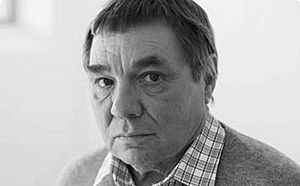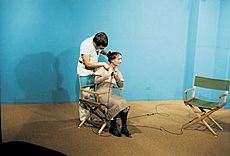Chris Burden facts for kids
Quick facts for kids
Chris Burden
|
|
|---|---|
 |
|
| Born | April 11, 1946 Boston, Massachusetts, US
|
| Died | May 10, 2015 (aged 69) Topanga Canyon, California, US
|
| Education | Pomona College University of California, Irvine |
| Known for | Performance art, installation art, sculpture |
| Spouse(s) | Barbara Burden Nancy Rubins |
Christopher Lee Burden (April 11, 1946 – May 10, 2015) was an American artist. He was famous for his unique and sometimes challenging performance art, as well as his amazing sculptures and installation art. Chris Burden was known for pushing the limits of what art could be. He created many well-known art pieces before he passed away in 2015.
Contents
Early Life and Education
Chris Burden was born in Boston, Massachusetts, in 1946. His father, Robert Burden, was an engineer, and his mother, Rhoda Burden, was a biologist. Chris grew up in different places, including Cambridge, Massachusetts, France, and Italy.
When he was 12, Chris had a serious motor-scooter accident. This accident led to a long recovery time. During this period, he became very interested in visual art, especially photography.
He went to Pomona College from 1965 to 1969. There, he studied visual arts, physics, and architecture. Later, he earned his master's degree (MFA) from the University of California, Irvine, between 1969 and 1971.
Exploring Art: Performance and Sculpture
Chris Burden started creating performance art in the early 1970s. These were often controversial because they involved personal risk. His first important performance, Five Day Locker Piece (1971), was for his master's project. For this piece, he stayed locked in a locker for five days.
Challenging Performance Art
Burden's art often explored ideas of danger and pushing boundaries. In his 1973 work 747, he fired shots from a pistol at a Boeing 747 airplane as it took off. Only one photographer witnessed this event.
One of his most famous early works was Shoot (1971). In this performance, an assistant shot him in the arm with a small rifle. This piece made many people talk about what art could be.
Other performances from the 1970s included Deadman (1972). For this, Burden lay on the ground covered by a canvas sheet and road flares. People thought he was dead and called emergency services. In Match Piece (1972), he launched lit matches at a woman.
In B.C. Mexico (1973), he kayaked to a lonely beach in Baja Mexico. He lived there for 11 days with only water. Velvet Water (1974) involved him trying to breathe water for five minutes in front of an audience.
Trans-Fixed (1974) is another well-known piece. For this, Burden lay on a Volkswagen Beetle car. Nails were hammered into his hands, making him look like he was crucified on the car. The car was then pushed out of a garage for two minutes.
Later that year, he performed White Light/White Heat. He spent 22 days lying on a platform in a gallery. He was out of sight and did not eat or talk during this time.
Another challenging piece was Doomed (1975). Burden lay still in a museum gallery under a large slanted glass sheet. He planned to stay there until a museum worker showed concern for his safety. After 40 hours, a worker placed water near him, and Burden ended the performance.
Moving to Sculptures and Installations
By the late 1970s, Burden began to create large, engineered sculptures. In 1975, he built the B-Car. This was a lightweight, four-wheeled vehicle. He said it could travel very fast and use fuel very efficiently.
Other works from this time include DIECIMILA (1977). This was a copy of an Italian 10,000 Lira banknote. The Speed of Light Machine (1983) recreated a science experiment. It allowed viewers to "see" the speed of light.
In 1978, Chris Burden became a professor at University of California, Los Angeles. He left this job in 2005. This was due to a disagreement about how the university handled a student's art performance.
In 1979, he showed his important Big Wheel exhibition. It was later shown again in 2009. In 1980, he created The Atomic Alphabet. This was a giant, hand-colored print. He also performed the text, stomping for each letter.
Samson (1988) was a huge hydraulic jack connected to a turnstile. Each person who entered the museum caused timbers to push into the museum's walls. The idea was that if too many people entered, the museum might collapse. The local fire department had to take it apart.
Later Works and Large-Scale Installations
Many of Chris Burden's later sculptures are very detailed. They often use many small parts. A Tale of Two Cities (1981) was inspired by war toys and model buildings. It showed two miniature city-states ready for war. It used 5,000 war toys and a huge sand base.
All the Submarines of the United States of America (1987) is another large installation. It has 625 small, handmade models of every United States submarine from the 1890s to the 1980s. They hang from the ceiling, looking like a school of fish.
In 1992, he showed Fist of Light. This was a sealed metal box with hundreds of bright lamps inside. It needed a special air conditioner to keep the room cool.
Hell Gate (1998) is a large model of a famous railroad bridge. It was built using Erector and Meccano pieces. In 1999, Burden's sculpture When Robots Rule: The Two Minute Airplane Factory was shown. This machine made model airplanes from tissue paper and wood. It launched each plane to fly around the gallery.
Nomadic Folly (2001) was first shown in Istanbul. It is a large wooden deck with huge umbrellas. Visitors could relax in this tent-like structure. It had beautiful handmade carpets and lamps.
In 2005, Burden created Ghost Ship. This was a crewless, self-navigating yacht. It traveled 330 miles from Fair Isle to Newcastle-upon-Tyne. Onboard computers and a GPS system controlled the ship.
In 2008, Burden created Urban Light. This sculpture uses 202 old street lights from around Los Angeles. It is outside the Los Angeles County Museum of Art. The lights are solar-powered and light up at dusk.
In 2011, Burden finished his moving sculpture, Metropolis II. It took four years to build. It shows a busy, fast-paced modern city with many small cars moving on tracks.
Porsche With Meteorite (2013) is a sculpture that balances a 1974 Porsche sports car and a small meteorite. They are on opposite ends of a long balance beam. The heavier car is closer to the center to keep it perfectly balanced.
Light of Reason (2014) was made for Brandeis University. It has three rows of 24 Victorian lamp posts. They point away from the museum's entrance. This sculpture acts as a gateway and a place for outdoor events.
Burden's last completed project was Ode to Santos Dumont. This was a working dirigible (a type of airship) that flies in perfect circles. It was named after a famous Brazilian aviator.
Exhibitions and Collections
Chris Burden's art has been shown in many important exhibitions. In 2013, the New Museum in New York presented "Chris Burden: Extreme Measures." This was a big show of his work. He also had major shows at the Newport Harbor Art Museum and the Museum of Applied Arts, Vienna.
His work is part of many famous museum collections. These include the LACMA and the Museum of Contemporary Art, Los Angeles in Los Angeles. His art is also in the Whitney Museum of American Art and the Museum of Modern Art in New York. Other places include the Tate Gallery in London and the Museum of Contemporary Art, Chicago.
Personal Life
Chris Burden was married to artist Nancy Rubins. He lived and worked in Los Angeles, California, in Topanga Canyon. From 1967 to 1976, he was married to Barbara Burden. She helped document some of his early art.
Chris Burden passed away on May 10, 2015. He was 69 years old.
Images for kids
See also
 In Spanish: Chris Burden para niños
In Spanish: Chris Burden para niños



